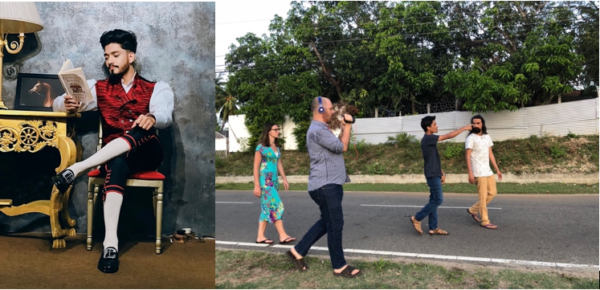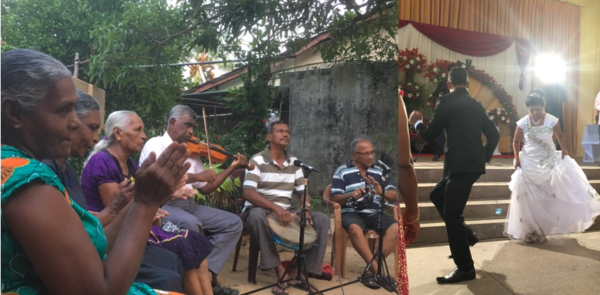New baila song puts Portuguese Burghers and their culture on a bigger stage – by Mahesh
An exciting new and trending baila release MINHA AMOR –Mee wadayaki – Remake by The Voice Sri Lanka contestant Derrick Keil puts a spotlight on Portuguese Burghers as well as the legacy of their unique music, dance and language.
The track is a medley of Portuguese Burgher káfriinha (or kaffringha) and Sinhala baila conceptualised and sung sweetly by Keil featuring music by Georgy, mixed and mastered by Amith Guru with a video clip directed by Sandesh Bandara.
Portuguese Burghers, their káfriinha and language
A small minority Eurasian community, Portuguese Burghers are particularly concentrated in Sri Lanka’s east where they maintain a number of their traditions. One of these is káfriinha, a social square dance comprising European melodies, African and Asian groove, and Portuguese medieval poetic influences. As this music became popular across the island during the 19th century it resulted in the further intercultural exchange which was at roots of Sri Lankan baila.
The lyrics for káfriinha songs are in Sri Lanka Portuguese, a language which grew out of contact between Portuguese and local people in Sri Lanka during the colonial era. Once a lingua franca across the island it has been a mothertongue for Portuguese Burghers, Dutch Burghers and Afro-Sri Lankans since the 16th century. Currently the language is spoken as an everyday language only by Portuguese Burghers in the east but is considered endangered due to the pressures of Tamil, Sinhala as well as English.
Nevertheless, Trincomalee born and bred Derrick Keil is part of a younger generation of fluent speakers of the language which he speaks in addition to Sinhala, Tamil and English. “I really want to make new Portuguese Burgher creations as well as remake versions of traditional káfriinha songs”, he said, reflecting his passion for bringing together the old and the new.
 Left: A moment from the Minha Amor clip. Right: Keil giving members of the Documentation of Sri Lanka Portuguese team (Patrícia Pardal Costa, Hugo Cardoso and Mahesh) a walking tour of his local area in Trincomalee in 2018. The tour was delivered entirely in Sri Lanka Portuguese. Photo on right by Mahesh White-Radhakrishnan.
Left: A moment from the Minha Amor clip. Right: Keil giving members of the Documentation of Sri Lanka Portuguese team (Patrícia Pardal Costa, Hugo Cardoso and Mahesh) a walking tour of his local area in Trincomalee in 2018. The tour was delivered entirely in Sri Lanka Portuguese. Photo on right by Mahesh White-Radhakrishnan.
What to listen out for in Minha Amor
Minha Amor brings refreshing reminders of the richness of Portuguese Burgher culture. While the clip and costuming both reflect popular tropes about the Portuguese prevalent in other baila songs (such as the delightful Kaprigngna by Corrine Almeida), the music in Minha Amor also strongly echoes Portuguese Burgher culture and music history.
The song features two Portuguese Burgher songs. The first is an old Portuguese Burgher song kuráánjaniita (also spelt Coranjanita) sometimes known in the community as Chikóóti (instrumental version by Batticaloa musicians here). It is a slow song (in a kind of waltz time) traditionally sung as a significant part of wedding rituals. Kuráánjaniita is known to baila lovers through upbeat versions in tracks by Desmond De Silva and AE Manoharan and Saman De Silva. An 1895 text described it as “one of the oldest of their tunes” highlighting its significance.
Also in the medley is a modern káfriinha song written in the 1970s, Vii minha ámoor pabayláá “come my love to dance”, attributed to Clarence Hendrick from Batticaloa. This song drew on the tune for the popular Sinhala baila song Mee Wadayaki Jeewite (attributed to C.T Fernando, Sisira Senarathne and Karunarathne Abayasekara) which was released in the late 1960s. This reflects an interesting case of borrowing back given the role of káfriinha in baila’s development. Keil sings both Vii minha and Mee Wadayaki Jeevithe bringin out this melodic resemblance.
Vii minha ámoor pabayláá is mainly performed in Batticaloa but is also known in Trincomalee. While it normally starts with the more serene chorus Keil’s wanted to do something different starting with the first verse which lifted the song and brought out the scope of its poetry:
fuula da róósa, fóóya teem veerdi, doos táám áálri yanasa
ásiley nósa ámoor yakresa nóós teem ooy ungaley
The rose has leaves of green and both were born from trees,
Like that our love grew and today we are as one
 Left: Portuguese Burgher musicians from Batticaloa including Remina Andrado, Frida Sellar and Jacinta de Silva all daughters of Clarence Hendrick, his son-in-law Iva Andrado (violin), Edward Outschoorn (rabáána) and Noel Sellar (saláári) sing for the Documentation of Sri Lanka Portuguese project. Right: Stefni and Jude Ragel from Batticaloa dance káfriinha at their wedding in May 2018. Photos by Mahesh White-Radhakrishnan.
Left: Portuguese Burgher musicians from Batticaloa including Remina Andrado, Frida Sellar and Jacinta de Silva all daughters of Clarence Hendrick, his son-in-law Iva Andrado (violin), Edward Outschoorn (rabáána) and Noel Sellar (saláári) sing for the Documentation of Sri Lanka Portuguese project. Right: Stefni and Jude Ragel from Batticaloa dance káfriinha at their wedding in May 2018. Photos by Mahesh White-Radhakrishnan.
Also featured in Minha Amor is Velanda Mozambicu, another old káfriinha tune which was well known in the 1850s by which time káfriinha was a popular dance across the island. This tune frequently features in baila songs including as an interlude in the 1978 hit Ayamma Kothaa Giya and is arguably one of the quintessential káfriinha tunes frequently encountered in baila tracks.
Looking to the future
Minha Amor marks an important moment in bringing káfriinha further into conversation with the broader Sri Lankan mainstream, attracting coverage from across the world including in Portugal for International Mother Language Day. Following this Keil hopes to broaden that reach even further with a multilingual song in Sri Lanka Portuguese, Tamil and Sinhala. Such efforts reflect a desire among the younger generation for their culture and language to have greater visibility and to situate it more within broader Sri Lankan and global culture evident in Sri Lanka Portuguese language teaching on Instagram, Sri Lanka Portuguese oral poetry, demonstrations of rituals such as the Way of the Cross in Sri Lanka Portuguese and podcast appearances, all an efflorescence of Portuguese Burgher cultural expression which will likely raise further awareness of their language and culture in the world.
Dr. Mahesh White-Radhakrishnan (they/them) is a singer and scholar of language and music based at Sydney Conservatorium of Music. They are the 2022 National Folk Fellow and winner of the ABC Top 5 for the Arts in 2022 and are a member of the Documentation of Sri Lanka Portuguese (DSLP) project team from the University of Lisbon led by Associate Professor Hugo Cardoso. The spelling used for káfriinha and most other Sri Lanka Portuguese words is based on the orthography developed by the DSLP project.







